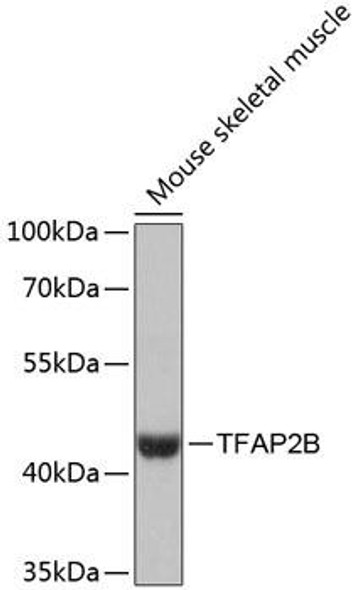Description
| Antibody Name: | TFAP2E Antibody (PACO60172) |
| Antibody SKU: | PACO60172 |
| Size: | 50ug |
| Host Species: | Rabbit |
| Tested Applications: | ELISA, WB |
| Recommended Dilutions: | ELISA:1:2000-1:10000, WB:1:500-1:5000 |
| Species Reactivity: | Human |
| Immunogen: | Recombinant Human Transcription factor AP-2-epsilon protein (66-175AA) |
| Form: | Liquid |
| Storage Buffer: | Preservative: 0.03% Proclin 300 Constituents: 50% Glycerol, 0.01M PBS, pH 7.4 |
| Purification Method: | >95%, Protein G purified |
| Clonality: | Polyclonal |
| Isotype: | IgG |
| Conjugate: | Non-conjugated |
 | Western Blot. Positive WB detected in: MCF-7 whole cell lysate. All lanes: TFAP2E antibody at 3.63µg/ml. Secondary. Goat polyclonal to rabbit IgG at 1/50000 dilution. Predicted band size: 47 kDa. Observed band size: 47 kDa. |
| Background: | Sequence-specific DNA-binding protein that interacts with inducible viral and cellular enhancer elements to regulate transcription of selected genes. AP-2 factors bind to the consensus sequence 5'-GCCNNNGGC-3' and activate genes involved in a large spectrum of important biological functions including proper eye, face, body wall, limb and neural tube development. They also suppress a number of genes including MCAM/MUC18, C/EBP α and MYC. AP-2-epsilon may play a role in the development of the CNS and in cartilage differentiation (By similarity). |
| Synonyms: | Transcription factor AP-2-epsilon (AP2-epsilon) (Activating enhancer-binding protein 2-epsilon), TFAP2E |
| UniProt Protein Function: | AP-2 epsilon: Sequence-specific DNA-binding protein that interacts with inducible viral and cellular enhancer elements to regulate transcription of selected genes. AP-2 factors bind to the consensus sequence 5'-GCCNNNGGC-3' and activate genes involved in a large spectrum of important biological functions including proper eye, face, body wall, limb and neural tube development. They also suppress a number of genes including MCAM/MUC18, C/EBP alpha and MYC. AP-2-epsilon may play a role in the development of the CNS and in cartilage differentiation. Belongs to the AP-2 family.Protein type: DNA-binding; Transcription factorChromosomal Location of Human Ortholog: 1p34.3Cellular Component: nucleusMolecular Function: protein homodimerization activity; protein heterodimerization activityBiological Process: transcription from RNA polymerase II promoter; regulation of transcription from RNA polymerase II promoter; anatomical structure development; positive regulation of transcription from RNA polymerase II promoter; regulation of cell proliferation |
| UniProt Protein Details: | |
| NCBI Summary: | |
| UniProt Code: | Q6VUC0 |
| NCBI GenInfo Identifier: | 194353976 |
| NCBI Gene ID: | 339488 |
| NCBI Accession: | NP_848643.2 |
| UniProt Secondary Accession: | Q6VUC0,Q8IW12 |
| UniProt Related Accession: | Q6VUC0 |
| Molecular Weight: | 46,212 Da |
| NCBI Full Name: | transcription factor AP-2-epsilon |
| NCBI Synonym Full Names: | transcription factor AP-2 epsilon (activating enhancer binding protein 2 epsilon) |
| NCBI Official Symbol: | TFAP2E |
| NCBI Official Synonym Symbols: | AP2E |
| NCBI Protein Information: | transcription factor AP-2-epsilon; AP2-epsilon; activating enhancer-binding protein 2-epsilon; adaptor-related protein complex 2, epsilon subunit |
| UniProt Protein Name: | Transcription factor AP-2-epsilon |
| UniProt Synonym Protein Names: | Activating enhancer-binding protein 2-epsilon |
| Protein Family: | Transcription factor |
| UniProt Gene Name: | TFAP2E |
| UniProt Entry Name: | AP2E_HUMAN |






